Another Timbre TimHarrisonbre
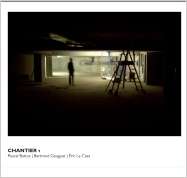
at55 chantier 1
Pascal Battus rotating surfaces, found objects
Bertrand Gauguet amplified & acoustic saxophones + effects
Eric La Casa microphones,recordings
7 tracks, 3-7 recorded at a working building site in Paris, September 2010
1-2 recorded in a studio in Paris, April 2011
Total Time: 62:10
Interview with Eric La Casa and Pascal Battus
'Chantier 1' clearly isn't an ordinary music recording. Can you tell us about the background to the project, and how it worked?
ELC: What is ‘an ordinary music recording’? Probably this is the heart of this project. I don’t make a ‘clear’ distinction between all the (sound) layers within the real. This means that my listening has no predetermined focus. Of course I have a long experience of listening and recording in many contexts. And this background forms the base of every new work. But I insist on this concept again: as a researcher (in humanities) I am always refining my recording processes when on site. I rarely have the answers before the recordings session itself because a site will often only reveal its density/complexity during the listening process, my survey. Channelling all those energies from the site, questions progressively appear and change...
I would say that this project is "clearly" (using your word) linked to my personal listening. I have been working on many site specific projects for 20 years or so... and especially with musicians in everyday contexts. In France, I have already made projects in metro stations, car parks, garages, houses, etc... And I think what is important to say is that I am involved as an improviser in all these projects. I am not making a technical recording; I use my microphones to improvise a relation between the context and the musicians... maybe the musicians become part of the context. I never consider my role as a technician. This is a huge difference when I start discussing a project with musicians. I am very active when I record and so am constantly listening to all sounds as part of a music in motion... a living music. Aim/intention and intuition/instinct are mixed up in one recording...
PB: Bertrand Gauguet and I have played together since 2006. There shouldn’t be any differences between acoustic and amplified instruments, but our instrumentation (alto saxophone and rotating surfaces) has led us to pay close attention to the acoustics of the places where we were playing. Out of that came the idea of playing and recording in locations which have a strong sonic identity. Eric la Casa – who’s familiar with both improvisation and phonography – was our choice for handling the recording.
After looking at several possibilities, we opted for a building site in Paris. The project had two phases: first the recording at the building site, then a recording at somewhere with a neutral acoustic, where we would try to recall our experiences of the building site.
The exact way in which things unfolded escapes me, because once on location it was a process of constant displacement. About twelve years ago a group in which I was active called TOPOPHONIE used to organise events at which about 20 artists of various sorts would go to a particular place ( a forest, a museum, a piece of uncultivated land, a laundrette…) and spend up to three hours or more listening and working there as dancers, musicians etc. In this sort of location-based work, and at the building site especially, I found myself on a completely unfamiliar ground, where I had to abandon my physical and mental habits to best capture the rich potential of the situation, and where concentration on sound alone had to give way to an attentiveness towards everything that was happening in the here and now (our effect on the workers, and vice versa).
Could you say a bit more about the interaction with the workers at the building site? I’d guess from just listening to the recordings that there was a mixture of different reactions to your presence and your music.
ELC : "Interaction" is a strong concept and I wouldn't use this word to describe what happened during the recording. Our relationship with the workforce was sincere but minimal because most of them were doing their regular jobs. As one of them said to another (who was watching and listening to us): "go back to work". And probably this was because we were all working as regular workers. But our musical presence on site provoked many reactions while playing / recording, and some questions during our breaks. Thanks to the manager, who helped out by following us around and briefly explaining our project to the workers, we finally made good contact with some Kurdish workers (mostly electricians) who were very interested in music and tried to demonstrate to us what music means in Kurdistan (sorry, Turkey). For example, at midday, during the break, a few workers sang a Kurdish song to us. And on the roof another Kurdish worker played some music (from his smartphone) to show us their traditional music and compare it with our improvisation (you can hear this on the last track of the cd).
Of course we needed permission to record in the building. So we’d met the manager and visited the site several weeks before recording. She agreed to allow us into any areas so long as we complied with the safety regulations (wearing a hard hat, for example). Her permission was given on the basis of her understanding of the project (she’s a great fan of improvised music) and her personal choice. So the workers themselves didn't know about our project and recording. They only found out during the recording itself. As you probably know, there are so many different jobs on a building site that it wasn’t possible to meet up with all the workers before the recording. Once on site, our relation with the workers wasn’t an interaction, but a friction of different people with different aims: the music created a zone of influences. But this is a very interesting question: from where or what can I consider my work or my life as being in interaction with my surroundings?
PB: The workers are the heart of the building site, but the site is a Tower of Babel with different and distinct communities (Africans, Arabs, Turks…), and communicating with them wasn’t always easy. The pressure to get on with their jobs was palpable, but didn’t prevent some extraordinary exchanges. Beyond an apparent indifference, or the need to focus on the job at hand, some of the workers showed a curiosity that could be either mistrustful or amused. One worker (perhaps a plumber) while passing Bertrand, who was making breathy noises into his sax, said ‘watch out, something’s leaking’. And, as Eric said, later when we were playing on the roof, one of the workers asked what we were doing, and when we explained and carried on, he took out his phone and made us listen to the music of his people: a Kurdish shepherd playing a kaval flute.
I like the fact that although we were all focused on what we were doing, there was a mutual respect and from time to time there were interruptions and communications.
Yes, I really like that moment you both refer to – in fact I really like the whole of that long last track. I didn’t realise till now that you were out on the roof at that point, but it makes sense because the track feels like an overview (metaphorically and literally) of the whole project. I find it quite magical the way that the ‘musical’ sounds Pascal and Bertrand are making now seem thoroughly integrated into the overall environment, one element amongst others. Does it feel different from the other tracks to you too?
ELC : There were two major differences. As you say, the first one was the position in the building; we were on the roof, and this made a big change in our perception of the whole site. The second difference was the workers themselves, who are directly interacting with us during the first minutes... they were also around us, looking at and listening to us. If I remember correctly, this was one of our last recordings, and it was mid-afternoon. Most of workers wanted to have a break (as we did). It was sunny and quite warm. On the roof, 6/8 men (no women) were moving around all the time at the beginning of the recording: some of them around us and others working on the roof and at the top of facade. The acoustics were very different from inside the building : no walls, a flat roof and a large courtyard... and wind. It was clearly an open space and a new context (in relation to the city, and its sounds) as compared to all the other recordings which were done inside the building (from the car park to offices and the atrium at the centre). This was the only recording we did outside the building. So there are a number of reasons why this recording was different, and why these differences renew our listening to the building and modify our understanding of the project.
PB: This track was the last recording on our journey. We were coming from a take inside the building which was rather trying both because of its length and the amount of energy used, and also because of the level of surrounding noise. So to come out onto the roof was in itself a welcome breath of fresh air. Sounds were no longer confined by four – or rather six – walls or surfaces, but seemed to be swallowed up into the sky from where they’d return as part of the general hubbub of the city. This is what gives the impression of the track being an overview of the whole, but is in fact just a real depth of sound which is perfectly captured by Eric: from the closeness of our sounds (and those of the workers around us), the voice of the Turkish labourer who spoke to me, to the cries of those working further away, and the distant crashes which came to us with a strong reverberation, along with the surrounding sounds of the city.
So let's go to the studio tracks. Although they're placed at the start of the disc, they were recorded later, and you said that you wanted 'a neutral acoustic where you could recall your experiences of the building site'. Could you explain how this 'remembering' worked in practice, and why did you choose to put these later 'memory' tracks at the beginning of the disc?
ELC: How to briefly speak about memory and its role in music? ...
Firstly it’s important to say again that the Gauguet /Battus duo was formed years before these recordings. So they already had a history of working together both in the studio and in concerts, so in fact their main issue was how to record with me and with the workers on the building site! This changes your question. For a musician a studio is more "natural". He can control all parameters and has no disturbance. In this case they’d had a strong sound experience on site and probably had a "score" in their memory... some of their gestures, sound situations, and feelings. You are probably right when you speak about a recall of a previous experience but it’s mixed in with their way of playing together in studio and live. The studio recordings were made after a period of a few months; they had to focus on just this experience, and to "forget" all the other ones. In my own mind I can still feel this experience, but I also realise that my memory of it is disturbed by many other experiences I’ve had both since and from before it. Improvisation was used as a trigger to reach across this lapse of time.
PB: The concept of ‘remembering the building site’ was left deliberately imprecise and offered a wide range of interpretations. Memory could be a point of departure or a driver, or it could be a modulator of our playing. And of course we’d already listened to the recordings, so they were also superimposed over our memories and might have denaturalised or even supplanted our sonic memories of the lived experience. At any rate for my part I regarded my own memories as being stretched synaesthetically to include my visual and tactile impressions of the building site. There the sounds a worker was making stopped whenever his task was finished, so I tried to find different logics for playing…something closer to making gestures than sound-production. And I have to say that for me it was relatively easy to consider the rotating surfaces that I was using – which can be really messy – as an activity in a workshop.
As to your second question, I think that the decision to put the studio tracks first allowed us to foreground the nature of the overall project, and perhaps to defy the expectations of the listener – which seems to have worked for you!
I find your project a particularly fruitful way of combining environmental sounds with music, and I notice that it's called 'Chantier 1'. Does this mean that you’re already planning other projects in different environments along the same lines?
PB Yes, we’re looking for other sites where we can further deepen the experience, and we’re also thinking about ways of realising such a project in concert… And I’m currently working on another piece which combines pure field recording with on site sonic gestures/playing, using trees as the common ground or meeting point.
ELC This is a very important question. When we start a project we don't think of all its consequences or its endpoint.; working on a project has no predetermined aim ... And during any particular process we are constantly inventing new paths or questions, which stretch our listening and test our tastes. The end result will take place within these collective- and self-explorations ... all these drifts into life. We experience our own capacity to travel together in one direction, maybe without any compass - improvisation as a social act. This is why we are all actively involved in improvisation: to find ways in which to surpass ourselves. I try to multiply my connections with the world and so with the people around me... to enlarge my little self. And when you find people with whom this is possible, you start a dialogue. With Chantier we touched on something that we had all ignored... something we are still trying to explain and to experience again. Because our trio is based on this site-specific sound experience in real time.
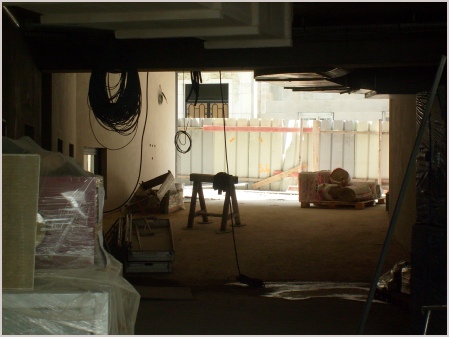
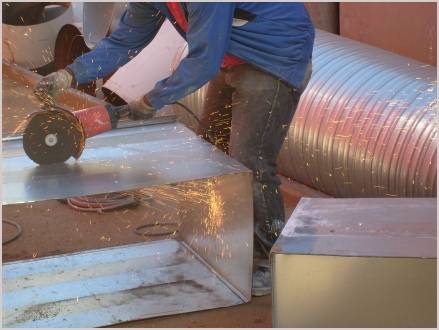
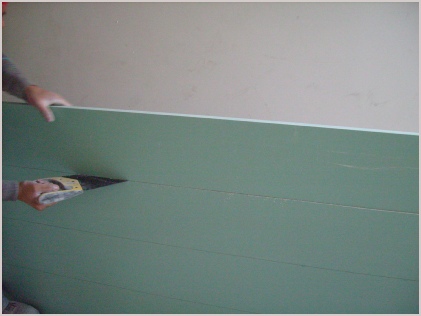


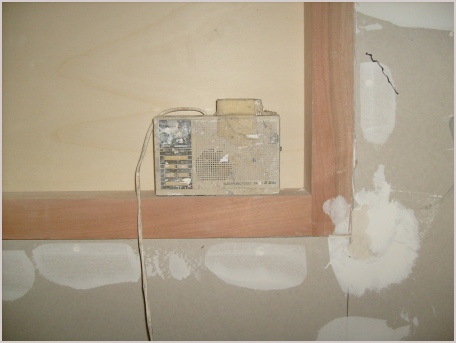
Reviews
“Tonight’s review then is of one of the most recent batch of discs from the Another Timbre label- an album named Chantier 1 by the trio of Pascal Battus, Bertrand Gauguet and Eric La Casa. Only the first two of the musicians actually play instruments or make sounds here however, with La Casa recording events, but as this isn’t quite your average album of improvised music then the importance of his role as more than just the recording engineer becomes clear. There are seven tracks on Chantier 1, the first couple of which are studio recordings of Gauguet’s saxophones, acoustic and amplified with effects, and Battus’ rotating surfaces and objects. The last five though feature the same two musicians, with the same instrumentation, playing together on a working building site in Paris.
The idea behind the project, is that the musicians would record themselves playing at the construction site, while all of the normal sounds of such a place went on around them, and then they would months later reconvene in a studio and try and remember the site and play together in a manner that reflected the earlier occasion. I was aware of this much before I put the CD into the player here for the first time. The liner notes on the disc also mention the building site recording before the studio one, so I automatically, but incorrectly, assumed that the first thing I would hear would be the building site pieces, with the late memories of them, which were recorded more than seven months later following on behind. The first two tracks here then are actually those made int he studio, but when I first listened I was doing so with the basic understanding in my head that I might also be hearing power tools etc alongside the instruments. I will admit that I was at first then a little disappointed that there was little distinction to be made between instruments and workers. the sounds I heard seemed to be similar to drilling, scraping and hammering sounds, but they also didn’t sound quite the real deal. So when the third track here began and immediately the construction site became a clear part of the recordings I checked the liner notes and realised the pieces were reversed. The interesting thing though, was that I was happy to accept that what I was hearing was the worksite recordings, which probably stands as a credit to the musicians’ attempts to recreate their memories of the day at the site.
While the opening two tracks consist of gritty, grinding, brittle improvisation then the really interesting stuff here begins at track three, when the recordings immediately sound like industrial site captures and the challenge is to track down the instrumental sounds amongst everything else. So there are crashes, drilling sounds, echoing scrapes and other aural detritus in here that probably belongs to the building site, but while many of the sax sounds are easily identifiable, some of them, and a great many of Battus’ little amplified scrapes and whirrs blend completely into their temporary environment. The closing track in particular is wonderful- as people shout and chatter to each other, even singing in places, and hammering, drilling and who knows what else echoes around La Casa’s expert recordings, so the two musicians just about disappear into the aural space. At one point one of the workers, having begun a conversation with the musicians decides to play a glimpse of Kurdish traditional music on his phone, to introduce his own culture into proceedings. If this final track seems to really illustrate a uniquely captured combination of musicians with unusual environment it also seems to capture a coming together of artists and workers in ways that were once commonplace but these days are rare.
If the opening tracks here feature some nice, gnarly improvisation, the idea to try and recover how the musicians felt in the construction site space is probably not as exciting as the actual recordings from the site themselves, which are a real joy to immerse yourself in from a listener’s perspective. I’m glad the extra tracks are here, I appreciate their importance and can imagine how much this additional perspective provided the musicians putting this work together, but after the first few listens to the disc I found myself starting later plays at track three where the richer, more varied sound environment suddenly engulfs the musicians’ inputs. However you listen though, this is an excellent CD capturing an original and inspired idea. The number 1 tacked on to the end of the album title suggests this may be the first release in a series of similar works. I hope this is the case.”
Richard Pinnell, The Watchful Ear
“Voici un disque qui fera date je l'espère. Car si on est plus ou moins habitué à entendre des artistes qui tentent d'interagir avec l'environnement sonore, des artistes qui choisissent des sites très spécifiques comme lieux d'enregistrements (grotte, usines désaffectée, gare, forêt, etc.), ces artistes se contentent seulement d'une relation avec le site lui-même, mais rarement avec un site habité. Il n'y a pas de relation entre la musique et l'homme, à moins que ce ne soit un public... La grandeur du trio Battus/Gauguet/La Casa, c'est de surpasser cette démarche qui tend à devenir une mode en créant une relation spécifique entre deux musiciens (Pascal Battus aux surfaces rotatives et objets trouvés, Bertrand Gauguet aux saxophones acoustiques et amplifiés plus effets), un site spécifique (un immeuble parisien en construction), et ceux qui l'habitent (les travailleurs).
Je suis un peu ennuyé de séparer Éric La Casa des deux instrumentistes, mais j'aimerais quand même justifier son accréditation peut-être surprenante mais pleinement justifiée. Car en effet, Éric La Casa ne joue pas d'instrument au sens classique du terme, il n'est peut-être crédité qu'aux microphones, mais cela ne doit certainement pas l'exclure du trio. Bien au contraire, il est plutôt le personnage central de ce trio dans la mesure où c'est bien lui qui joue le plus sur les relations possibles entre le site et les musiciens. Dans ce trio, même s'il ne produit pas de son, il assure la continuité matérielle entre la musique et l'environnement, et avec brio. Pour l'anecdote, j'ai écouté une fois ce disque un matin au beau milieu des Causses du Larzac, dans une vallée aride et désertée. J'écoutais ce disque au casque, et plusieurs fois, je me suis surpris à me demander d'où venaient les sons, je retirais plusieurs fois mon casque pour m'assurer qu'il n'y avait pas un camion-benne où une scie à métaux plus haut dans la vallée. Car l'attention extrêmement sensible de La Casa aux divers sons présents sur le site lui permet de leur rendre toute leur profondeur, tout leur espace. La vie des travailleurs et du chantier peut parfois être au centre de l'environnement, parfois lointaine, et c'est cette gestion incroyable de l'espace sonore, cette gestion beaucoup plus musicale que technique, qui permet d'intégrer le preneur de son aux artistes. Car il ne fait belle et bien rien d'autre qu'improviser avec le site et les musiciens, qu'improviser avec un talent hors du commun.
Plus concrètement, qu'est-ce qu'on peut entendre sur ce disque? Le disque est divisé en deux parties: la première a été enregistré en studio, quelques mois après l'expérience du Chantier. On y entend Pascal Battus et Bertrand Gauguet improviser deux pièces en tachant de se remémorer la situation d'enregistrement initiale, sans prendre en compte leurs expériences précédentes - car le duo existe depuis 2006. Feuilles de papiers, plastiques et autres surfaces sont mises en vibration, sont frottés par des mécanismes circulaires et rudimentaires. Des textures abrasives et granuleuses auxquelles Gauguet répond par une multiplicité de techniques étendues. Les deux strates se mêlent, se mélangent et se confondent dans un jeu d'imitation alchimique. Une interaction plutôt incroyable entre l'acoustique, les préparations et l'électronique qui s'entremêlent indistinctement. Une absence totale de hiérarchie entre les sources, ce qu'on retrouve également dans les cinq merveilleuses pièces suivantes. Car pour l'enregistrement in situ, le principe est le même. Il s'agit de confondre les sources, d'y répondre avec le même respect que s'il s'agissait d'une partition - quand bien même il s'agit d'une production électroacoustique, d'un son des travailleurs, d'une note de saxophone, de l'architecture du lieu, jusqu'au discours des travailleurs eux-mêmes. De l'eau qui coule, un camion-benne, des scies à métaux, des marteaux, se mêlent à des sons de surfaces rotatives et de saxophones, sans hiérarchie ni mise en avant de l'un comme de l'autre. L'écoute des musiciens est précise, attentive, sensible, chacun réagit à l'autre et à l'environnement sonore et humain avec une musicalité, un profond respect, une humilité, une discrétion et une sensibilité hors du commun.
Mais toute la force de ce Chantier réside peut-être dans les réactions qu'a su susciter cette expérience - réactions qui sont pleinement acceptées et intégrées à la performance, le but étant même de les solliciter et d'y répondre. Je pense par exemple à la dernière pièce, où la musique s’interrompt lorsqu'un turc d'origine kurde parle de sa vision de la musique aux musiciens et leur fait écouter un air traditionnel de flûte qawal. Voilà pour la réaction la plus forte, mais c'est également l'aspect documentaire qui est remarquable, car l'enregistrement saisit d'une part la multiplicité des travaux sur le lieu de construction à travers les sons des engins utilisés (maçonnerie, plomberie, métallerie, etc.), mais également la multiplicité ethnique des travailleurs (africains, arabes, kurdes) - reflet flagrant de l'exploitation salariale (ou non) des flux migratoires des masses sous-prolétarisées.
Un disque extrêmement marquant et bien sûr hautement recommandé. Avec Richard Pinnel, je ne peux qu'espérer une suite à cette expérience remarquable qui parvient à surpasser ce qui tend parfois à devenir une démarche formelle (je parle de l'intégration de l'environnement sonore). En ce sens, c'est à dire en tant qu'il surpasse et dépasse une certaine esthétique ou une certaine logique artistique, on pourrait presque dire que Chantier 1 est un disque transcendant, en tout cas, il marque une nouvelle étape dans l'histoire toujours en cours des musiques.”
Julien Heraud, Improv-Sphere
“A recording of a project in two parts in which the second is presented first. Battus (rotating surfaces, found objects) and Gauguet (saxophones, amplified and not, other effects) creatively recorded by La Casa, played in a construction site amongst workers there. But they later performed in a "neutral" space, their music based on memories of what occurred earlier. It's these (two) tracks which are presented first, an odd strategy in that the listener (unless he's read about it at the Another Timbre site) doesn't have the same frame of reference as the musicians. I
When the third cut appears, the first thing noticed is how much the space has opened, the volume of air flowing about. Whatever surfaces Battus is rotating and metal tubes down which Gauguet is propelling breath, when integrated with water, whistling, the banging of things unloaded, hammering and chatter, they sound far, far more interesting and, surely, of their environment. In that such sites often employ rotating surfaces and forced-air devices of their own, the four latter pieces become, essentially, field recordings in the classic sense, albeit it pretty enjoyable ones, particularly the last, longest piece which includes (per the conversation at the AT site), some Kurdish music off a worker's cell, a fine cultural cross-reference to a people disinterested in Western affects like...field recording.”
Brian Olewnick, Just Outside
“Depuis longtemps Eric La Casa (accompagné ici par Pascal Battus et Bertrand Gauguet) poursuit sa démarche d'intégration de l'environnement sonore - plus particulièrement industriel qu'il avait entamé à la fonderie Pacard - à ses travaux. L'insertion et l'interaction avec les sites industriels établissent surtout un lien entre la musique et ceux qui travaillent dans de tels lieux. Pascal Battus (aux surfaces rotatives et avec divers objets récupérés) et Bertrand Gauguet (aux saxophones amplifiés et modifiés par divers effets) trouvent en Eric La Casa - qui n'est pas musicien au sens classique du terme - un "preneur de sons" d'exception. Il reste la pièce maîtresse du trio. Si Battus et Gauguet "jouent", le troisième crée la jointure entre la musique et l'environnement industriel.
L'effet est prodigieux en particulier au casque : le vrombissement de camions-bennes, les stries d'une scie à métaux trouvent dans le mixage de La Casa avec les instruments de ses acolytes une profondeur inédite. Les travailleurs du chantier semblent parfois au coeur même du dispositif qui reste cependant beaucoup plus sonore que technique. Le rôle de La Casa est donc essentiel : il prend le rôle d'un metteur en scène et d'un metteur en ondes en devenant l'improvisateur capable de jongler avec les sons hybrides.
La première partie du disque est enregistrée en studio après l'expérience du chantier in situ. Battus et Gauguet improvisent deux pièces en tâchant de se remémorer la situation d'enregistrement initiale. Feuilles de papiers, plastiques et autres surfaces sont mises en vibration, sont frottées par des mécanismes circulaires simples. Aux textures abrasives et granuleuses de Battus et Gauguet font écho les dérives du saxo. Ces deux éléments sonores se mélangent par l'imbrication subtile entre l'acoustique et l'électronique. La musique n'a pas le "pas" sur l'environnement. Mais l'inverse est vrai aussi : La Casa refuse une quelconque hiérarchie entre les deux sources.
Les cinq pièces suivantes de l'album - qui en constituent la seconde partie - ont été enregistrées in situ. Mais elles répondent à la même intention. L'objectif reste de mêler les deux sources selon une structure digne d'une partition "classique" : création électroacoustique, bruits émis par les travailleurs, plages de saxophone, discussions des ouvriers, tout est mis sur le même plan. Intensités sonores d'écoulements aquatiques, de motteuxrs, de scies, de marteaux se lient à celles des surfaces rotatives et de saxophones.
Il y a là une recherche rarissime qu'on ne peut jamais réduire à un simple bruitisme. Bien au contraire l'organisation de deux strates se fait précise, attentive comme si tous les participants - musiciens ou non - étaient à l'écoute des autres. Surgit une émotion particulièrement dans ce qui représente bien plus une expérience qu'une simple "performance" sonore - même s'il ne faut pas occulter cet aspect de l'oeuvre qui ouvre sur une autre dimension de l'opus.
Dans la dernière pièce la musique s'interrompt soudain : un travailleur kurde évoque sa vision de la musique au trio et lui fait écouter un air traditionnel de flûte qawal. Néanmoins l'entreprise dépasse le document. Certes, à partir de cette source analytique d'enregistrement d'une multiplicité des travaux surgit aussi la présence d'un choeur particulier : celui des Africains, Arabes, Kurdes, bref des ethnies prolétaires du chantier. On peut donc entendre une manifestation d'une certaine exploitation humaine. Mais sous les affres implicites et grâce aux trois artistes surgit aussi d'une culture en mouvement dans une audition la plus proche de ce qui est de la vie d'un chantier. Celle d'une pluralité bâtie sur l'étendue en mettant l'accent sur le fait que la musique est construite dans la frontière entre deux mondes mais aussi comme appel au dépassement des frontières.”
Jean-Paul Gavard Perret, Revue et corrigé
Discount price £5